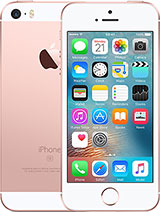Apple iPhone SE Radiation Levels
| Radiation Levels | Head | Body | Hot Spot |
|---|---|---|---|
| Cellular Only | 1.14 W/kg | 1.14 W/kg | 1.14 W/kg |
| Wi-Fi + Cellular | 1.59 W/kg | 1.58 W/kg | 1.56 W/kg |
Apple iPhone Se SAR Level Summary:
The cellular transmission SAR values for the Apple iPhone Se (FCC ID BCG-E3042A) are 1.14 W/kg (watts per kilogram) at the head and 1.14 W/kg when worn on the body. The hotspot/Airplay SAR level is 1.14 W/kg. The simultaneous transmission SAR values for iPhone SE (cellular plus Wi-Fi) is 1.59 W/kg at the head, 1.58 W/kg when worn on the body, and 1.56 W/kg when used as a hotspot simultaneously with other transmitters active.
iPhone SE
| Select a phone to compare iPhone SE SAR levels to other popular phones |
| Cell Phone Usage & Radiation Exposure | ||||||||||||
Apple iPhone SE Safety Tip:How Much Will Turning Off Wi-Fi and Bluetooth Reduce Radiation?This SAR chart reveals how turning off Wi-Fi and Bluetooth on your Apple iPhone SE can significantly reduce your exposure to radiation. Our SAR comparison chart shows that by simply turning off Wi-Fi and Bluetooth transmitters, you can lower the RF radiation exposure to your head by 28.3%, and you can lower exposure to the body by 27.8%, when considering these differences between cellular-only (Wi-Fi/Bluetooth OFF) and simultaneous use exposure (Wi-Fi/Bluetooth ON), a wise way to reduce excessive phone radiation is to tap off unnecessary transmitters when not in use! Additionally, when using your phone as a hotspot, turning off Bluetooth can reduce your exposure by up to 36.8% according to the FCC SAR report for device number BCG-E3042A. Apple iPhone SE SAR Levels
|
Key Takeaways
- Children vs Adults: Children have higher SAR levels due to thinner skulls and developing tissues, making them more vulnerable to radiation.
- Wi-Fi Impact: Simultaneous use of cellular and Wi-Fi transmission increases SAR levels for all age groups.
- Precautionary Measures: Using radiation protection products like QuantaCase can help mitigate these risks, especially for younger users.
By understanding these differences, parents and guardians can make informed decisions to better protect their children from excessive microwave radiation exposure, emphasizing the need for safer smartphone usage practices and protective accessories like QuantaCase.

| Children vs Adults Radiation Exposure |
The Specific Absorption Rate (SAR) of a mobile device measures the amount of radio frequency energy absorbed by the body during device usage.
The SAR values for the iphone-se (FCC ID BCG-E3042A) are as follows:
- 1.14 W/kg when held at the head with cellular transmission only
- 1.14 W/kg when worn on the body with cellular transmission only
- 1.14 W/kg when used as a Hotspot or Airplay
- 1.59 W/kg when held at the head with simultaneous cellular and Wi-Fi transmission
- 1.58 W/kg when worn on the body with simultaneous cellular and Wi-Fi transmission
- 1.56 when used as a Hotspot simultaneously with other transmitters active.
Apple iPhone SE - SAR Levels
FCC SAR Levels
- FCC Approval Date This is the date the phone SAR test was completed before the phone's release to the public as required by law. 02 February 2016
- FCC ID The FCC ID is the code used to register a device for FCC compliance BCG-E3042A
- Head SAR Level SAR test when held against your head when only using cellular service. Wifi and other transmitter are NOT active 1.14 W/kg
- Body SAR Level SAR test when held against your body only using cellular service. Wifi and other transmitter are NOT active 1.14 W/kg
- Product Specific Use SAR test when held against your body only using the phone as a hotspot. Cellular and other transmitter are NOT active 1.14 W/kg
- Simultaneous Head The highest possible SAR test when held against your HEAD with cellular and WiFi transmitters active, 1.59 w/kg
- Simultaneous Body The highest possible SAR test when held against your BODY with cellular and WiFi transmitters active, 1.58 w/kg
- Hotspot SAR The highest possible SAR test when held against your BODY using the phone as a hotspot with cellular and WiFi transmitters active, 1.56 w/kg
EU SAR Level
- Head SAR Level 0.97 W/kg
- Body SAR Level 0.99 W/kg
Test reports filed with the U.S. Federal Communications Commission (FCC), the Specific Absorption Rate (SAR) for the iPhone SE for cellular transmission only at the head is 1.14 watts per kilogram (w/kg), same goes for when worn on the body the SAR is 1.14 w/kg too. The wireless router SAR is also 1.14 w/kg.
The SAR for simultaneous transmission (cellular plus Wi-Fi) is 1.59 w/kg at the head, 1.58 w/kg when worn on the body, and 1.56 w/kg when the phone is used as a hotspot.








